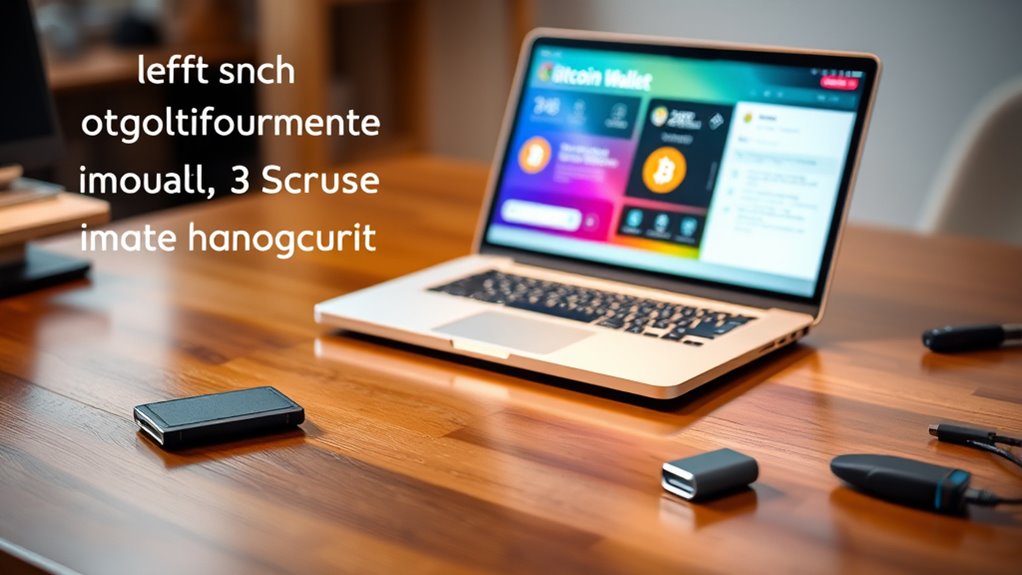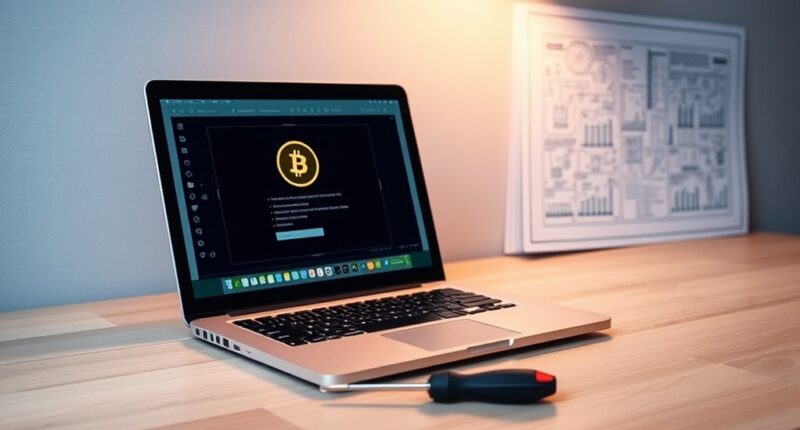To quickly turn your old laptop into a secure Bitcoin wallet, wipe the device completely, then install a privacy-focused OS like Tails or a live Linux distro from external media. Keep it offline by disabling all network connections and physically disconnecting power when not in use. Generate and secure your wallet offline, transfer unsigned transactions via USB, sign them offline, and broadcast signatures online. Following these steps now sets a strong foundation—continue to learn more advanced tips for ultimate security.
Key Takeaways
- Wipe the laptop completely, then install a privacy-focused OS like Tails or a live Linux distribution from external media.
- Disconnect all network interfaces and disable WiFi and Ethernet before setup to ensure offline operation.
- Generate Bitcoin wallets and private keys entirely offline using secure wallet software, then encrypt and back up the files securely.
- Prepare unsigned transactions on an online device, transfer them via USB to the offline laptop for signing, then export signed transactions for broadcasting.
- Regularly verify backup integrity, keep the device powered down when not in use, and implement strong encryption and security practices.

If you have an old laptop lying around, you can repurpose it into a highly secure, offline Bitcoin wallet. Start by wiping the device completely and dedicating it solely for cold storage or offline wallet use. Make sure the laptop can boot from external media like USB drives or DVDs, as this feature is vital for running a secure, isolated environment. Disable all network interfaces—turn off WiFi and unplug Ethernet cables—to create an air-gap, ensuring the laptop remains disconnected from the internet at all times. For added security, physically disconnect the battery and power supply when the device isn’t in use, reducing the risk of remote hacking or physical tampering. Next, format the hard drive and install a secure, privacy-focused OS such as Tails OS or a live Linux distribution like Ubuntu Live CD. These operating systems are designed for privacy and leave no traces after shutdown, minimizing malware risks. Modern OS complexity increases attack surface and info leaks Once your OS is set up, boot from an external drive to run the system in a live environment. Install a Bitcoin wallet supporting offline wallet creation, like Electrum or Bitcoin Core in offline mode. Generate your wallet and private keys entirely offline to keep them secure and unexposed to the internet. Encrypt your wallet file (wallet.dat) with a strong, unique password, adding an extra layer of protection. Save backups of your wallet and Bitcoin addresses on USB drives, and consider exporting them to physical media such as CDs. These backups should be stored securely, ideally in multiple locations, so you can recover your funds if needed. Distribute copies to trusted contacts if possible, and always encrypt backups before storing them in cloud services or online storage. Creating and signing transactions is straightforward with this setup. On an online computer, prepare unsigned transactions using your public keys or watch-only wallets. Transfer these files via USB to your offline laptop, load them into your wallet software, and sign the transactions securely without an internet connection. Then, export the signed transaction back onto USB drives, and move it to an online device for broadcasting to the Bitcoin network. Regularly verify your backups by restoring them on an offline machine, ensuring they work properly. Maintain strict security practices: keep the laptop powered down and disconnected when not in use, use strong, unique passwords for encryption, and verify the integrity of your software before installation. Using tools like Electrum, Tails OS, or Ubuntu Live, you can efficiently establish a robust cold storage system in under 30 minutes, turning your old laptop into a highly secure Bitcoin vault. Additionally, periodically checking for software updates helps maintain security and compatibility over time.
Frequently Asked Questions
Is This Method Suitable for Beginners?
This method might not be ideal for complete beginners because it involves some technical steps, like software installation, encryption, and seed phrase management. If you’re new to Bitcoin and computers, you could find the process challenging and might make security mistakes. However, if you’re willing to learn and follow instructions carefully, you can successfully set up a secure wallet. Just be prepared to spend extra time and seek support if needed.
Can I Use This on Windows and Mac?
Like a trusty Swiss Army knife, you can definitely use a Bitcoin wallet on both Windows and Mac. Most popular wallet software, such as Electrum, Bitcoin Core, Sparrow, and Wasabi, support both operating systems seamlessly. Just make certain you download from official sources, keep your system secure, and consider pairing with a hardware wallet for added safety. This way, your old laptop becomes a versatile and secure tool for managing your Bitcoin.
How Often Should I Update the Wallet?
You should update your wallet whenever a new version is released, especially if it includes security patches. Hot wallets need frequent updates, possibly monthly, to stay protected from online threats. Cold wallets require less frequent updates, mainly firmware improvements. Always enable automatic updates if possible, and back up your wallet beforehand. Regularly monitoring official channels and community sources guarantees you’re aware of critical updates to keep your funds secure.
Will This Protect Against Hardware Theft?
You wonder if turning your old laptop into a Bitcoin wallet protects against hardware theft. While it offers some offline security, it doesn’t match dedicated hardware wallets’ tamper resistance. Without secure elements or tamper-evident features, your laptop is vulnerable to physical attacks. Encryption, strong passwords, and secure storage of recovery phrases help, but ultimately, a hardware wallet provides better protection against theft, especially if you prioritize physical security.
What Are Common Mistakes to Avoid?
You should avoid common mistakes like neglecting backup security, which leaves private keys vulnerable if stored insecurely. Don’t forget to verify backup integrity regularly, especially if using handwritten seeds. Keep your software updated to patch vulnerabilities and prevent malware attacks. Also, don’t use outdated hardware or insecure storage locations. Failing to implement these practices risks losing access to your funds or exposing your private keys to theft.
Conclusion
By repurposing your old laptop into a secure Bitcoin wallet, you’re giving it a second life while safeguarding your digital assets. Just remember, a chain is only as strong as its weakest link—so keep your security measures tight. With a little effort, you can turn tech clutter into a fortress for your crypto. It’s true what they say: “An ounce of prevention is worth a pound of cure.” Stay vigilant and enjoy your crypto journey!









